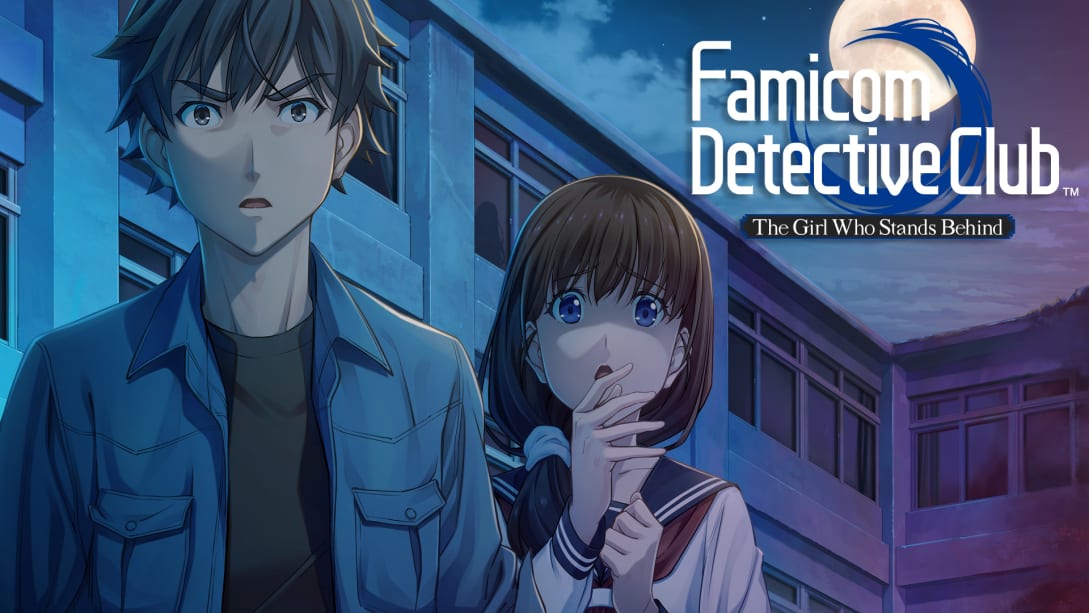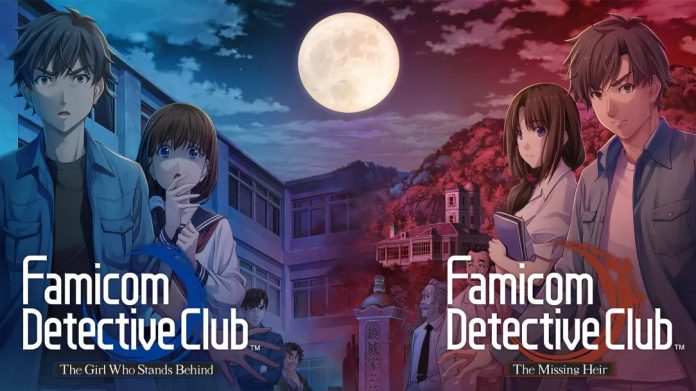I am all about mystery games and visual novels, especially in anime-style. So, when I saw the new two-game Famicom Detective Club release, I was excited to play it and try it out. Full disclosure: I never played the original 1980s versions, but a lot of people in North America probably haven’t, as the original games were only released in Japan. So, for those of you wondering what these new versions of the games are like, and the pros and cons of their playthroughs, continue reading for my full review of Famicom Detective Club: The Missing Heir and Famicom Detective Club: The Girl Who Stands Behind on the Nintendo Switch.
About the Games

Originally released in 1988, The Missing Heir was the first of the two Famicom Detective Club games to be released by Nintendo. With its success came the release of The Girl Who Stands Behind the following year.
This year, Nintendo released new remakes of the detective games, allowing players to experience the games in a modernized way, while also giving North American players a way to experience them for the first time.
Both Famicom Detective Club games follow the same character–a male, teenaged protagonist who you name and exclusively play as in both games–and his life as a detective, focusing on one case at a time. Although you don’t have to know one game to understand the other–you can play either game independently–I think it would be helpful and more enjoyable to play The Girl Who Stands Behind before The Missing Heir. There is a linear plot outside of the cases.
Technically, The Missing Heir is the first game that was released, and if you want to play them true to the original release order in Japan, you would need to play this one first. The Girl Who Stands Behind was released later, as a prequel game. However, I played The Missing Heir first and was confused as to who my character was and why I was so young.
If you play The Missing Heir first, you won’t have the backstory to your character yet, and the game’s story later on won’t be as appreciated. I would suggest playing The Girl Who Stands Behind first, as it technically takes place first, explains the plot and characters, and doesn’t spoil things that happen later on.
Again, if you want to play in the original order, The Missing Heir is the way to go. I, personally, however, highly suggest anyone wanting to play these games to start with The Girl Who Stands Behind. I think it would make the entire experience more enjoyable and satisfying.
The Girl Who Stands Behind Plot

Of the two games, The Girl Who Stands Behind was the most compelling and intriguing to me. I found myself wanting to solve this game’s mystery a lot more than I did for The Missing Heir. Your character is a male fifteen-year-old who has run away (and this is the same character you play in The Missing Heir). You are taken in by the local detective, who makes you his assistant in a case of a girl who was just murdered in a small town in Japan. Both you and the head detective work on individual cases that slowly come together into one. Nintendo.com explains the plot as follows:
As an up-and-coming detective, find the culprit who took the life of an innocent girl and rattled her high school community. The victim was investigating a ghost story of a bloody girl who haunts the school and appears behind students. Deconstruct this grisly rumor at Ushimitsu High School and free these students from their nightmare.
The Missing Heir Plot

Despite the fact that The Girl Who Stands Behind was a lot more exciting, The Missing Heir still had compelling aspects and a good ending for the two games’ stories. And although I think it would be best to start with The Girl Who Stands Behind, there is still a benefit to starting with The Missing Heir. The reason for this is that you start out not knowing who you are at the beginning of The Missing Heir. You slowly figure out who you are and what you’re doing as the game goes on. And as was mentioned earlier, this was the first game originally released.
Nintendo.com explains the plot as follows:
The mystery begins when a man named Amachi discovers your unconscious body on a cliff in the Japanese countryside. Clouded with amnesia, you learn that you are a detective and must return to your case—solving a murder involving the wealthy Ayashiro family. Uncover the secrets of the Ayashiro family, find the murderer, and regain your lost memories.
What I Liked

There were a lot of things to like about these games, and some things to dislike. For now, though, let’s focus on the positive.
Something I really liked about these games were the graphics. I’ve played a lot of visual novels, and I saw a lot of similarities between these two Famicom Detective Club games and Root Letter. But these games had really great graphics going for them. Root Letter had good art, as all visual novels seem to (the good ones, anyway), but the ones in Famicom Detective Club were top-notch. The characters moved and behaved naturally, rather than just being still images moving from one pose to another. I thought this was a really cool addition to the game. The characters seemed more real, and it felt more immersive because of it.
I also liked the “review the plot so far” feature. I think this is an option that should be included in every story-heavy game out there. In Famicom Detective Club, you can choose to review the story and what has happened so far. This was an especially handy feature since it’s a mystery game, which is obviously why it’s included. If I put the game down and didn’t play it for a week, I’d have a hard time remembering some details or certain characters’ names. And in the game, you sometimes have to write in who you think someone is talking about or where you think something is. If you are lost and haven’t kept track of things, you might have to go through your notes for a long time, or look up the answer via a walkthrough online.

Speaking of notes, this was another handy feature included in the games. Although I didn’t use them personally, the game saves notes of important information that your character learns in his investigation. This acts as a way for you to put things together yourself if/when you’re stuck.
There is also a speculation aspect, where your character sits down and gathers his thoughts, trying to figure things out. I thought that all of these little details throughout the games were really well done and added to the overall detective feel of the games.

In addition to all of this, the soundtrack was really fitting, and you can choose between the new, revamped soundtrack or the original 8-bit soundtrack.
What I Didn’t Like
While there was a lot to like about these games, I soon learned that there was a big hole that impacted my gameplay experience. When I played through the first of the two games, I quickly realized how tedious they both could be. They were unnecessarily tedious at times and required more work than needed. Although this is only one aspect of the game, it affected the overall gameplay experience so much that it made me dislike playing it a lot of the time.
It was too bad, too, because I was really into the stories, especially in The Girl Who Stands Behind, but having to figure out the particular orders of what to say and do over and over again in the same situations got old pretty quickly. It doesn’t sound like a big deal, but when you’re trying to move through a story quickly, being bogged down by these time-consuming, oftentimes boring, steps over and over again, you quickly get sick of it.
For example, at times you would have to ask a character the same questions repeatedly, or in different order, in order to continue the story. And other times, the story wouldn’t progress unless you resorted to random tactics of going different places, thinking, talking to people in a certain order, and going back to the original location. It was frustrating and unnecessary. I would have much preferred if the games were consolidated in their gameplay so fewer unnecessary steps were involved.
Other than the fact that those parts were tedious, they weren’t difficult to figure out; they were just boring and required more time than needed. The combination of what to do and ask made the game drag on a lot of the time. It wasn’t like I was figuring out an actual mystery during those times (as that would have been more exciting); it was just monotonous.
Words of Advice

If you are interested in playing through these Famicom Detective Club games, the following are some notes that may help you in your playthroughs:
- Make sure you click on everything when searching/examining. Sometimes what you need is something obvious, and other times it’s something you’d least expect or what had never led to progress in the story before.
- You sometimes have to try things a few times before anything happens/progresses (ex. You have to go somewhere else and then talk to someone or observe something else at this new location and then go back to where you were before you can discover what is needed. Sometimes the first time you go somewhere isn’t when something major happens, either. You go there and observe the surroundings, go somewhere else and do what you need to (no matter how small), and then go back and something will happen).
- Sometimes you have to choose the same option multiple times. For example, in chapter four of The Missing Heir, when talking to an employee, I needed to ask about Jiro twice before things progressed. Also, in chapter six of the same game, you have to pester Heikichi multiple times, call for Yukiko a couple times, and then call for Heikichi again so that you compliment him before he tells you his secret and things progress.
Overall Thoughts

I think that people who played the original Famicom Detective Club games would appreciate these remakes, and I’m sure many others will enjoy them, too. However, I went in expecting more fast-paced, exciting games than I found myself playing. I think that if the creators of these remakes consolidated things and made them a little more modernized in gameplay, it would have been more enjoyable. Granted, I never played the original ones, but I’m assuming they were the same way because this doesn’t seem like the pace of a game that would be made today (especially when looking at the recently made Root Letter).
The original games were likely revolutionary in the late 80s when they were released, but we have so many visual novels now, including compelling mysteries, so relying on the old ways of these games created an obstacle in my ability to enjoy them more fully (if this really was the case). And if, for some reason, the originals didn’t feature this type of gameplay and the creators chose to make these new editions this way solely for these new editions, I would just flat-out say that the gameplay was too unnecessarily tedious and that I don’t understand why they were made that way.
I did enjoy the stories, the graphics, and the music, though. I just wish some of the gameplay was consolidated so things ran more smoothly and weren’t unnecessarily complicated at times. My advice to any who play these games would be to ask questions over and over again and try any option available when trying to progress through the story. Even if that means going out of a location and going back in. You never know what combination might work. That was the aspect I didn’t like, but it’s a good thing to know going in.
The bottom line is this: if you aren’t a huge mystery game-player, these probably aren’t the games for you. However, if you do like a good mystery, anime-style games, and visual novels, and you don’t mind the aspects of the games that drag on, you might absolutely love them. For me, however, it was probably a 7/10.
If you are curious and interested in playing these games for yourself, be sure to comment and let us know what your thoughts are, or let us know on Twitter!



